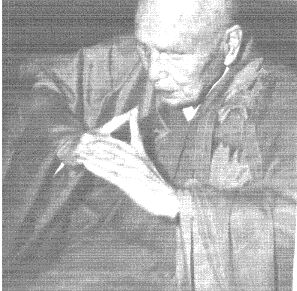| This text is based upon a talk given in August 1977 by Shifu
Nagaboshi to students of the London Shingon group at the Hakurenji Temple.
Prior to this the students had requested Shifu to explain further the
meaning of certain terms they had come across in their reading or studies.
This explanation is therefore mainly a response to this and covers the
themes of all these enquiries. It was originally tape recorded and later
annotated by a member of Hakurenji and further explanations were added
later by Shifu in order to make clearer some of the points covered. This
text was kindly transcribed by Gen-Ryu Tomio.
Introduction - The Esoteric Studies Within Shingon the fields of experiential spiritual practice are summarised in what is known as the 'Sammitsu', a term meaning the 'three esoteric studies'. These studies involve attaining an understanding of the Mind, Body and Speech of Mahavairocana Buddha (of which more later) and their correspondences within the Mind, Speech and Body of the practitioner. Such studies can be applied in many different manners.

Traditionally the Sammitsu are expressed in the form of mudra, mantra and mandala. Mudra are the special signs or postures adopted, usually with the hands, to symbolically represent aspects or principles of a Buddha's wisdom. Mantra are the sacred sounds, syllables or chants which constitute the words of an enlightened one. Mandala are ornate and often beautiful graphic or other representations of the knowledges and powers of the enlightened ones. These often take highly ornate patterns and contain figures, symbols, signs, shapes and colours. All teachings concerning the Sammitsu are esoteric or 'Mikkyo', inner rather than outer teachings. The word 'esoteric' does not mean 'secret'; rather it indicates something not easily understood - in other words, what is seen, whether it be visually or mentally, is not necessarily all that there is. That the same thing can be represented in many different forms leads to an appreciation of interactive symbolism, a characteristic which is strongly emphasised and appreciated within esoteric Buddhism. Sometimes this is seen in simple associations such as when a ritual bell, the Kane - used to mark the different stages of a ritual - is understood to represent the voice of the Buddhas, or the Kongo, a symbol of the thunderbolt also used in rituals, is seen to represent the power of wisdom to cut through delusions.
|